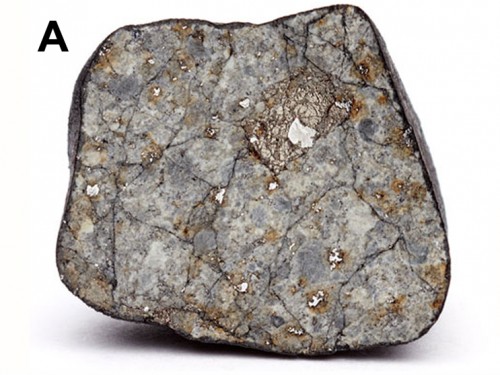
Exhibit A: a 4 cm-wide meteorite created by the Chelyabinsk asteroid explosion with “shock veins” in it. (Courtesy: Science/AAAS)
By Matin Durrani
If there is one thing that will be remembered about Friday 15 February 2013, it’s that it was the day when a massive asteroid blew up above the city of Chelyabinsk in Russia – creating the largest explosion on the planet since the one that occurred over the Tunguska river in Siberia in 1908.
But whereas hardly anyone saw or recorded information about the Tunguska explosion, the Chelyabinsk asteroid blew up over a relatively densely populated region and – perhaps more importantly – its journey through the air was recorded by numerous cameras and webcams that nervous Russian drivers love to install on their cars. Video footage of the event was soon seen by people all over the world.
Now, based on data from those videos and visits to some 50 local villages, researchers from the Czech Republic and Canada have published a paper in the journal Science detailing the trajectory, structure and origin of what they call the “Chelyabinsk asteroidal impactor”. The paper goes live on Thursday 7 November.
To save you the trouble of reading the full article, I’ve picked out a couple of factoids that might intrigue and interest you.
• The Chelyabinsk asteroid entered the atmosphere with a mass of 13,000 tonnes (with a factor of 2 uncertainty) and a diameter of 19.8 m (plus or minus 4.6 m).
• When it blew up, it was travelling at almost 70,000 km/h and – depending on different estimates – produced an airburst with an energy equivalent to about 470–590 kilotonnes of TNT. The Tunguska explosion, in contrast, had an estimated energy of 5–15 megatonness of TNT.
• The asteroid created a shockwave that formed about 90 km above the ground, before breaking into small pieces at altitudes of 45–30 km. Directly below the fireball’s path, the shockwave was strong enough to blow people off their feet.
• People found it painful to look at the bright fireball, with 2.2% of the 1113 people who responded to an Internet survey saying that it had given them sunburn.
• About 44% of all apartments in Chelyabinsk suffered shattered and broken glass, although no buildings were structurally damaged. However, a statue of the Russian novelist Alexander Pushkin in a local library was cracked by a blown-out window.
• Between 4 and 6 tonnes of the asteroid survived the explosion (roughly 0.03–0.05% of the initial mass), creating various meteorites that landed on the ground, including one that made a 7 m hole in 70 cm-thick ice sheet on Lake Cherbarkul. In total, some 76% of the asteroid evaporated, with most of the rest turning to dust.
• Based on studies of its internal composition, the researchers suggest that the Chelyabinsk asteroid is an LL chondrite – the same type as the asteroid Itokawa, from which the Japanese probe Hayabusa collected samples a few years ago.
Meanwhile, two other papers in Nature also examine the science of the asteroid. One concludes that a common technique for estimating airburst damage “does not reproduce the observations”, while the other says that the total mass of surviving fragments larger than 100 g was “lower than expected” and that that the number of impactors with diameters of tens of metres may be “an order of magnitude higher than estimates based on other techniques”.
The conclusion? Well, I suppose it shows just how useful on-board car cameras can be. It’s possibly a whole new take on “citizen science”!
I have my own M theory:
Space is a gigant sphere that expanded so fast that cracked in some parts. Through those cracks time is “shorten” when any particle or force goes from point A to point B. Those cracks are the black holes. Space is still expanding so the cracks are changing their tension levels, therefore their behavior. That tension is a force created with no relation to matter at all..its pure force.
I hope you like it…
Marianna